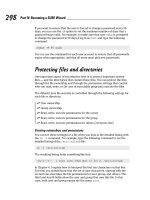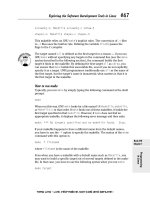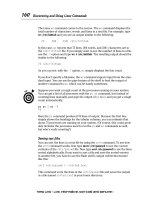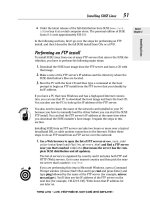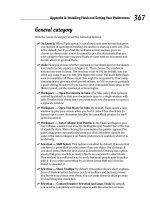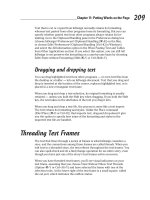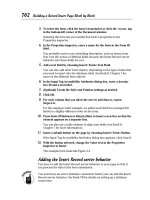JavaScript FOR ™ DUMmIES phần 10 pdf
Bạn đang xem bản rút gọn của tài liệu. Xem và tải ngay bản đầy đủ của tài liệu tại đây (1.74 MB, 44 trang )
sun
Description: A top-level object used to access any Java class in the package
sun.*.
What creates it: Automatically created by Java-supporting browsers.
How to access it:
Packages.sun
(See Packages.)
Text
Description: A text field included in an HTML form.
What creates it:
<FORM NAME=”formName”> . . . <INPUT TYPE=”text”
NAME=”textName” . . . ></FORM>
How to access it: document.formName.textName or formName.elements[i]
Properties: defaultValue, form, name, type, value
Methods: blur(), focus(), handleEvent(), select()
Event handlers: onBlur, onChange, onFocus, onSelect
Textarea
Description: A text area element (a multiline text input field) included in an
HTML form.
What creates it:
<FORM NAME=”formName”><TEXTAREA NAME=”textarea
Name”> . . . </TEXTAREA></FORM>
How to access it: document.formName.textareaName or formName.
elements[i]
Properties: defaultValue, form, name, type, value
Methods: blur(), focus(), handleEvent(), select()
Event handlers: onBlur, onChange, onFocus, onSelect
323
Appendix C: Document Object Model Reference
29_576593 appc.qxd 10/12/04 10:05 PM Page 323
window
Description: A browser window or frame.
What creates it:
<BODY>
<FRAMESET>
<FRAME NAME=”frameName”>
window.open(“windowName”)
How to access it:
self
window
window.frames[i]
window.frameName
Properties: closed, defaultStatus, document, frames[], history,
length, location, Math, name, navigator, offscreenBuffering, opener,
parent, screen, self, status, top, window
Netscape Navigator only: crypto, innerHeight, innerWidth, jav, location
bar
, menubar, netscape, outerHeight, outerWidth, Packages, page
XOffset
, pageYOffset, personalbar, screenX, screenY, scrollbars,
statusbar, sun, toolbar
Internet Explorer only: clientInformation, event
Methods: alert(), blur(), clearInterval(), clearTimeout(), close(),
confirm(), focus(), moveBy(), moveTo(), oen(), prompt(), resizeBy(),
resizeTo(), scroll(), scrollBy(), scrollTo(), setInterval(),
setTimeout()
Netscape Navigator only: atob(), back(), btoa(), captureEvents(),
disableExternalCapture(), enableExternalCapture(), find(),
forward(), handleEvent(), home(), print(), releaseEvents(),
routeEvent(), setHotkeys(), setResizable(), setZOptions(), stop()
Internet Explorer only: navigate()
Event handlers: onBlur, onDragDrop, onError, onFocus, onLoad, onMove,
onResize, onUnload
324
Part VI: Appendixes
29_576593 appc.qxd 10/12/04 10:05 PM Page 324
Global Properties
Infinity
NaN
(not a number)
Undefined
Built-In JavaScript Functions
escape()
Description: Returns the hexadecimal encoding of an argument in the
ISO-Latin-1 character set. The
escape() function and it’s reverse function,
unescape(), are typically used to send special characters safely from a
JavaScript script to another program, such as a Java applet. For example,
you can encode a special character by using the
escape() function and
send the resulting value to another program that can then decode that char-
acter by using the equivalent of the
unescape() function — and vice versa.
(Sending special characters without using this encoding process can result
in errors. You can think of the ISO-Latin-1 character set as a lowest-common-
denominator language that many programmer languages understand.)
Syntax:
escape(“valueToBeEncoded”)
Example:
escape(“&”) // returns the hexadecimal equivalent of & which is “%26”
eval()
Description: Evaluates a string of JavaScript code without reference to a par-
ticular object.
Syntax:
eval(“value”) where value is a string representing a JavaScript
expression, statement, or sequence of statements. The expression can
include variables and properties of existing objects.
Example:
eval(new String(“2+2”)) // returns a String object containing “2+2”
325
Appendix C: Document Object Model Reference
29_576593 appc.qxd 10/12/04 10:05 PM Page 325
isFinite()
Description: Evaluates an argument to determine whether it is a finite
number. If the argument is
NaN, positive infinity or negative infinity, this
method returns
false; otherwise, it returns true.
Syntax:
isFinite(value)
Example:
isFinite(123) // returns true
isNaN()
Description: Evaluates an argument to determine whether it is not a number.
Returns
true if passed NaN and false otherwise.
Syntax:
isNaN(value)
Example:
isNaN(123) // returns false
Number()
Description: Converts the specified object to a number.
Syntax:
Number(anObject)
Example:
alert (Number(d)) // Displays a dialog box containing “819199440000.”
parseFloat()
Description: Parses a string argument and returns a floating point number.
Syntax:
parseFloat(“value”)
Example:
var x = “3.14” // returns 3.14
326
Part VI: Appendixes
29_576593 appc.qxd 10/12/04 10:05 PM Page 326
parseInt()
Description: Parses a string argument and returns an integer of the specified
radix or base. (Base 10 is assumed if no radix is supplied.)
Syntax:
parseInt(string[, radix])
Example:
parseInt(“1111”, 2) // returns 15
parseInt(“15”, 10) // returns 15
String()
Description: Converts the specified object to a string.
Syntax:
string(anObject)
Example:
aDate = new Date (430054663215)
alert (String(aDate)) // displays “Thu Aug 18 04:37:43 GMT-0700 (Pacific
Daylight Time) 1983.”
taint()
Description: Adds tainting to a data element or script. (Tainting a JavaScript
element prevents that element from being passed to a server without the
end-user’s permission.)
Syntax:
taint([dataElementName]) where dataElementName is the prop-
erty, variable, function, or object to taint. If omitted, taint is added to the
script itself.
Example:
taintedStatus=taint(window.defaultStatus)
327
Appendix C: Document Object Model Reference
29_576593 appc.qxd 10/12/04 10:05 PM Page 327
unescape()
Description: Returns the ASCII string for the specified hexadecimal encoding
value.
Syntax:
unescape(“value”) where value is a string containing characters
in the form
“%xx”, xx being a 2-digit hexadecimal number.
Example:
unescape(“%26”) // returns “&”
untaint()
Description: Removes tainting from a data element or script. (Tainting a
JavaScript element prevents that element from being passed to a server
without the end-user’s permission.)
Syntax:
untaint([dataElementName]) where dataElementName is the
property, variable, function, or object from which to remove tainting.
Example:
untaintedStatus=untaint(window.defaultStatus)
328
Part VI: Appendixes
29_576593 appc.qxd 10/12/04 10:05 PM Page 328
Appendix D
Special Characters
S
ometimes you need to represent special characters in JavaScript strings.
Common examples of special characters include white space, currency
symbols, and non-English characters.
When you represent special characters in JavaScript, you have a choice:
You can use escape characters, octal, or hexadecimal representations of
the Web-standard character set Latin-1 (ISO 8859-1), or — for versions of
Netscape Navigator including 6.0 and later — Unicode.
Together, the ISO 8859 and Unicode standards allow for literally tens of thou-
sands of special characters: enough to represent most of the known human
languages! Although I couldn’t fit all of them in this appendix, the following
tables should cover most of your special character needs. It lists the most
commonly used special characters, along with both the hexadecimal and
octal representations JavaScript supports.
Character sets are evolving standards. To get the very latest scoop on
JavaScript internationalization and supported character sets — as well as
to find representations for special characters not listed in this appendix —
check out the section of Netscape’s JavaScript manual that describes support
for special characters at
/>ident.html#1009568
For more information on the Unicode standard, check out the Unicode home
page at
www.unicode.org
The following is example of how you use special characters in JavaScript code:
alert(“\’JavaScript For Dummies\u00A9\’ costs $29.99 in the U.S., 195\xA5 in
Japan, and \24316 in Britain.”)
30_576593 appd.qxd 10/12/04 10:04 PM Page 329
Here are the most commonly used special characters:
Character JavaScript Escape Unicode
Characters
Apostrophe \’ \u0027
Backslash \\ \u005C
Backspace \b \u000b
Carriage return \r \u000D
Double quote \” \u0022
Form feed \f \u000C
New line \n \u000A
Tab \t \u0009
Octal, hexadecimal, and Unicode representations of other common special
characters appear in the following lists:
Octal Hex Unicode Description Character
\240 \xA0 \u00A0 Nonbreaking space
\241 \xA1 \u00A1 Inverted exclamation mark ¡
\242 \xA2 \u00A2 Cent sign ¢
\243 \xA3 \u00A3 Pound sign £
\244 \xA4 \u00A4 General currency sign €
\245 \xA5 \u00A5 Yen sign ¥
\246 \xA6 \u00A6 Broken vertical line _
\247 \xA7 \u00A7 Section sign §
\250 \xA8 \u00A8 Diaeresis or umlaut ¨
\251 \xA9 \u00A9 Copyright sign ©
\252 \xAA \u00AA Feminine ordinal indicator ª
\253 \xAB \u00AB Left-pointing double carets «
\254 \xAC \u00AC Logical not-sign ¬
330
Part VI: Appendixes
30_576593 appd.qxd 10/12/04 10:04 PM Page 330
Octal Hex Unicode Description Character
\255 \xAD \u00AD Soft hyphen _
\256 \xAE \u00AE Registered sign ®
\257 \xAF \u00AF Macron ¯
\260 \xB0 \u00B0 Degree sign °
\261 \xB1 \u00B1 Plus-or-minus sign ±
\262 \xB2 \u00B2 Superscript two _
\263 \xB3 \u00B3 Superscript three _
\264 \xB4 \u00B4 Acute accent ´
\265 \xB5 \u00B5 Micron sign >
\266 \xB6 \u00B6 Pilcrow ¶
\267 \xB7 \u00B7 Middle dot ·
\270 \xB8 \u00B8 Cedilla ¸
\271 \xB9 \u00B9 Superscript-one _
\272 \xBA \u00BA Masculine ordinal indicator º
\273 \xBB \u00BB Right-pointing double carets »
\274 \xBC \u00BC Fraction, one-quarter
1
⁄4
\275 \xBD \u00BD Fraction, one-half
1
⁄2
\276 \xBE \u00BE Fraction, three-quarters
3
⁄4
\277 \xBF \u00BF Inverted question mark ¿
Uppercase Letters
\300 \xC0 \u00C0 A-grave À
\301 \xC1 \u00C1 A-acute Á
\302 \xC2 \u00C2 A-circumflex Â
\303 \xC3 \u00C3 A-tilde Ã
\304 \xC4 \u00C4 A-umlaut Ä
(continued)
331
Appendix D: Special Characters
30_576593 appd.qxd 10/12/04 10:04 PM Page 331
Uppercase Letters (continued)
\305 \xC5 \u00C5 A-ring
\306 \xC6 \u00C6 AE ặ
\307 \xC7 \u00C7 C-cedilla ầ
\310 \xC8 \u00C8 E-grave ẩ
\311 \xC9 \u00C9 E-acute ẫ
\312 \xCA \u00CA E-circumflex ấ
\313 \xCB \u00CB E-umlaut ậ
\314 \xCC \u00CC I-grave è
\315 \xCD \u00CD I-acute
\316 \xCE \u00CE I-circumflex ẻ
\317 \xCF \u00CF I-umlaut ẽ
\320 \xD0 \u00D0 D-stroke _
\321 \xD1 \u00D1 N-tilde ẹ
\322 \xD2 \u00D2 O-grave ề
\323 \xD3 \u00D3 O-acute ể
\324 \xD4 \u00D4 O-circumflex ễ
\325 \xD5 \u00D5 O-tilde ế
\326 \xD6 \u00D6 O-umlaut ệ
\327 \xD7 \u00D7 Multiplication sign ì
\330 \xD8 \u00D8 O-slash ỉ
\331 \xD9 \u00D9 U-grave
\332 \xDA \u00DA U-acute
\333 \xDB \u00DB U-circumflex
\334 \xDC \u00DC U-umlaut ĩ
\335 \xDD \u00DD Y-acute _
\336 \xDE \u00DE THORN _
\337 \xDF \u00DF Small sharp s (
332
Part VI: Appendixes
30_576593 appd.qxd 10/12/04 10:04 PM Page 332
Lowercase Letters
\340 \xE0 \u00E0 a-grave
\341 \xE1 \u00E1 a-acute ỏ
\342 \xE2 \u00E2 a-circumflex õ
\343 \xE3 \u00E3 a-tilde ó
\344 \xE4 \u00E4 a-umlaut ọ
\345 \xE5 \u00E5 a-ring ồ
\346 \xE6 \u00E6 ae ổ
\347 \xE7 \u00E7 c-cedilla ỗ
\350 \xE8 \u00E8 e-grave ố
\351 \xE9 \u00E9 e-acute ộ
\352 \xEA \u00EA e-circumflex ờ
\353 \xEB \u00EB e-umlaut ở
\354 \xEC \u00EC i-grave ỡ
\355 \xED \u00ED i-acute ớ
\356 \xEE \u00EE i-circumflex ợ
\357 \xEF \u00EF i-umlaut ù
\360 \xF0 \u00F0 d-stroke _
\361 \xF1 \u00F1 n-tilde ủ
\362 \xF2 \u00F2 o-grave ũ
\363 \xF3 \u00F3 o-acute ú
\364 \xF4 \u00F4 o-circumflex ụ
\365 \xF5 \u00F5 o-tilde ừ
\366 \xF6 \u00F6 o-umlaut ử
\367 \xF7 \u00F7 Division sign ữ
\370 \xF8 \u00F8 o-slash ứ
\371 \xF9 \u00F9 u-grave ự
\372 \xFA \u00FA u-acute ỳ
(continued)
333
Appendix D: Special Characters
30_576593 appd.qxd 10/12/04 10:04 PM Page 333
Lowercase Letters (continued)
\373 \xFB \u00FB u-circumflex û
\374 \xFC \u00FC u-umlaut ü
\375 \xFD \u00FD y-acute _
\376 \xFE \u00FE thorn _
\377 \xFF \u00FF y-umlaut ÿ
334
Part VI: Appendixes
30_576593 appd.qxd 10/12/04 10:04 PM Page 334
Appendix E
About the CD
T
his appendix explains what’s on the CD-ROM that accompanies this book,
as well as how to install the contents and run each of the examples. Here’s
a sneak-peek at the contents for those of you who just can’t wait:
ߜ Full working copies of each of the HTML/JavaScript listings that appear
in the book
ߜ A wealth of useful JavaScript development tools
ߜ Sound and image files used in the examples
Getting the Most from This CD
The best way to get familiar with JavaScript is to load scripts and interact
with them as you read through each chapter. If it’s feasible for you, I suggest
installing the contents of the CD before you pick up the book (or at least before
you’re more than about a quarter of the way through). Then, when you come
across a listing in the book, you can double-click on the corresponding HTML
file you’ve already installed and bingo! Interactive learning.
If you really want to make sure that you understand a concept, be sure you
take time not just to run each file, but to play around with it, too. Change a
line of JavaScript code and see what happens. You can’t go wrong because
you can just reinstall from the CD.
The examples are also referenced throughout the text. Some were designed
to reinforce the concepts you’re discovering; others, to be real, live, workable
scripts that you can incorporate into your own Web pages. Enjoy!
31_576593 appe.qxd 10/12/04 10:10 PM Page 335
System Requirements
Make sure that your computer meets the minimum system requirements listed
here. If your computer doesn’t match up to most of these requirements, you
may have problems in using the contents of the CD.
ߜ A Pentium-based PC, or a Mac OS computer with a Power PC-based
processor.
ߜ Microsoft Windows 98 or later, Windows NT4 or later, or Mac OS system
software 8.5 or later.
ߜ A copy of either Netscape Navigator 7.0 or Microsoft Internet Explorer 6.0.
(Chapter 1 tells you how to get a copy and install it, if you haven’t already.)
ߜ At least 16MB of total RAM installed on your computer. For best perfor-
mance, I recommend that Windows-equipped PCs and Mac OS computers
with PowerPC processors have at least 32 MB of RAM installed.
ߜ At least 25MB of hard drive space on a Windows PC or at least 10MB
of hard drive space available on a Mac OS computer to install all the
software from this CD. (You’ll need less space if you don’t install every
program.)
ߜ A CD-ROM drive — double-speed (2x) or faster.
ߜ A sound card for PCs. (Mac OS computers have built-in sound support.)
ߜ A monitor capable of displaying at least 256 colors or grayscale.
ߜ A modem with a speed of at least 14,400 Kbps and an Internet connection
(to connect to the World Wide Web).
If you need more information on the basics, check out these books published
by Wiley Publishing, Inc.: PCs For Dummies, by Dan Gookin; Macs For Dummies,
by David Pogue; iMacs For Dummies by David Pogue; Windows 95 For Dummies,
Windows 98 For Dummies, Windows 2000 Professional For Dummies, Microsoft
Windows ME Millennium Edition For Dummies, all by Andy Rathbone.
Using the CD
1. Insert the CD into your computer’s CD-ROM drive. The license agree-
ment appears.
• Windows users: The interface won’t launch if you have autorun
disabled. In that case, click Start ➪ Run. In the dialog box that
appears, type D:\start.exe. (Replace D with the proper letter if
your CD-ROM drive uses a different letter. If you don’t know the
letter, see how your CD-ROM drive is listed under My Computer.)
Click OK.
336
Part VI: Appendixes
31_576593 appe.qxd 10/12/04 10:11 PM Page 336
• Note for Mac Users: The CD icon will appear on your desktop. Double-
click the icon to open the CD and double-click the “Start” icon.
2. Read through the license agreement, and then click the Proceed button
if you want to use the CD. After you click Proceed, the License Agreement
window won’t appear again.
The CD interface appears. The interface allows you to install the pro-
grams and run the demos with just a click of a button (or two).
JavaScript For Dummies Chapter Files
Each of the chapter listings that appear in the book is contained on the
companion CD in the CHAPTERS folder. The naming convention used is
list####.htm, where # corresponds to each specific chapter and listing
number. For example, you can find Listing 8-1 in the file named list0801.htm.
In addition to the chapter listings, the CD contains multimedia files and addi-
tional files for your review. To see a list and description of these items, please
see the text file LISTINGS.TXT, located in the CHAPTERS folder.
You may find it more convenient to copy the CHAPTERS folder to your hard
drive. To install the files, you can choose the install option from the CD-ROM
interface.
What You’ll Find
In addition to HTML files containing the JavaScript chapter listings, the fol-
lowing development tools are on the companion CD. Many of the tools are
either trial versions or shareware, which means if you like the product and
use it regularly, you need to contact the company directly and arrange to
purchase a copy of your very own.
Apycom DHTML Menu from Apycom Software, Inc. is a shareware tool you
can use to create customized DHTML menus — without coding. DHTML
Menu supports Internet Explorer, Navigator, and other browsers running
on Windows, Mac, or UNIX. For more details, point your Web browser
BBEdit (Demo). From Bare Bones Software, BBEdit text editor available for
the Macintosh that makes a great HTML editor, too. Get the skinny on BBEDut
abd Bare Bones by visiting
337
Appendix E: About the CD
31_576593 appe.qxd 10/12/04 10:11 PM Page 337
Dreamweaver Trial Version. Dreamweaver is an industrial-strength Web
development tool that runs on both Windows and Power Mac; it also works
hand-in-glove with Macromedia’s Web-animation development tool, Flash.
To purchase a copy of your very own — or just to get more information on
Dreamweaver — visit
/>Macromedia HomeSite 30-day evaluation version. HomeSite, from
Macromedia, is an HTML editor for Windows with many features that make
Web programming a breeze. You can add and check tags, anchors, and for-
matting quickly. You can find updates at
/>Paint Shop Pro Evaluation Version. JASC Inc.’s Paint Shop Pro is a share-
ware graphics viewing and editing tool available for Windows. You can find
updates at
/>SmartMenus DHTML Menu. From SmartMenus.org comes this fast, stable
DHTML menu creation tool that’s free for use in non-commercial Web sites.
For conditions of use and sample menus, visit
/>Web Weaver Demo Version. McWeb Software’s Web Weaver is a professional
HTML editor for Windows platforms. The “gold” version offers spell checking
and a few other features not found in the evaluation version. For details, visit
/>
If You Have Problems (Of the CD Kind)
I tried my best to find shareware programs that work on most computers
with the minimum system requirements. Alas, your computer may differ, and
some programs may not work properly for some reason.
If you have problems with the shareware on this CD-ROM, the two likeliest
problems are that you don’t have enough memory (RAM) or that you have
other programs running that are affecting installation or running of a pro-
gram. If you get an error message such as
Not enough memory or Setup
cannot continue
, try one or more of the following suggestions and then try
using the software again:
338
Part VI: Appendixes
31_576593 appe.qxd 10/12/04 10:11 PM Page 338
ߜ Turn off any antivirus software running on your computer. Installation
programs sometimes mimic virus activity and may make your computer
incorrectly believe that a virus is infecting it.
ߜ Close all running programs. The more programs that you have running,
the less memory is available to other programs. Installation programs
typically update files and programs. So if you keep other programs run-
ning, installation may not work properly.
ߜ Have your local computer store add more RAM to your computer.
This is, admittedly, a drastic and somewhat expensive step. However,
adding more memory can really help the speed of your computer and
allow more programs to run at the same time.
If you still have trouble installing the items from the CD, please call the
Wiley, Inc. Customer Service phone number at 800-762-2974 (outside the U.S.:
317-572-3994), visit our Web site at
/>Wiley provides technical support only for installation and other general quality-
control items; for technical support on the applications themselves, consult
the program’s vendor or author.
To place additional orders or to request information about other Wiley prod-
ucts, please call 800-225-5945.
339
Appendix E: About the CD
31_576593 appe.qxd 10/12/04 10:11 PM Page 339
340
Part VI: Appendixes
31_576593 appe.qxd 10/12/04 10:11 PM Page 340
• Symbols •
+ (addition operator), 51
&& (“and” logical operator), 51
<> (angle brackets), 263
*/ (asterisk, forward slash), 37
@ (at symbol), 219
\w+ (backslash, w, plus sign), 219
() (call operator) precedence, 51
^ (carat), 219
, (comma)
functions, declaring, 42
precedence order, 51
?: (conditional operator), 51
{ } (curly braces), 38
— (decrement operator), 50
$ (dollar sign), 219
. (dot symbol), 219
==, |= (equality operator), 51
! (exclamation point), 230
/ (forward slash), 219
/* (forward slash, asterisk), 37
> (greater than sign), 263
++ (increment operator), 50
< (less than sign), 263
% (modulus operator), 50
- (negation operator), 51
|| (“or” logical operator), 51
; (semicolon)
expression, checking, 39
precedence order, 51
[] (square brackets), 38
• A •
About Focus on JavaScript Web page, 257
accessing
browser, 12
cookies, 133–134
CSS objects with JavaScript, 86
Java class (
netscape), 316
multiple Java classes (
packages), 317
sun.* package, 323
top-level Java class (
java), 312
addition operator (+), 51
address input, validating, 216, 217–220
address, Web
accuracy of listed, 3
currently loaded (
location), 314
link opened in frame, viewing, 143
visited (
history), 312
advertisement, pop-up
alert, creating, 79
error messages, 230
event handlers, 243–244
software barring, 147, 247
alert window, creating, 79
Allen, Dan (DOM Tooltip creator), 211
AllWebMenus (Likno Software)
site map tool, 200
America Online browser, 16, 271
anchor hyperlink target, 304
anchor
TARGET attribute, 153
“and” logical operator (&&), 51
angle brackets (<>), 263
animation
described, 19, 157–161
hotspots, 168
navigation bars, 168
rollovers, 168–171
slideshow series of images, 165–168
support, 17
turning images on and off, 161–164
appearance
Web page, 17
Web site, 18
applet
described, 157
DOM reference (
applet), 304
application
attaching script to HTML file, 30–32
described, 23
HTML file, creating, 25–28
requirements, determining, 24
script, creating, 29
testing script, 32–33
Index
32_576593 bindex.qxd 10/12/04 10:10 PM Page 341
Apycom Software DHTML Menu
back-of-the-book CD, 338
described, 190
archives, newsgroup, 283
area
TARGET attribute, 153
argument, string
floating point number, parsing and
returning (
parseFloat()), 326
specified radix or base (
parseInt()),
parsing and returning, 327
arguments
DOM, 305
function, declaring, 42
array, 305
array data, 99
ASCII string, returning for specified hexa-
decimal encoding (
unescape()), 328
assignment operators
described, 52
precedence, 51
asterisk, forward slash (*/), 37
at symbol (@), 219
attributes
JavaScript cookies, 132, 133
properties versus, 76
automatic events, 18, 80
• B •
backslash, w, plus sign (\w+), 219
Baroudi, Carol (Internet For Dummies), 258
BBEdit (Bare Bones Software), 338
behaviors. See methods, DOM
binary and unary operators, 50
_blank attribute, 153
blinking text, 80
blocking
frames, 154
pop-up advertisements, 147, 247
blocks, creating exceptions with, 250–252
blur-related event handlers
focus, changing, 240, 243
user input, capturing, 220, 221
boolean value
described, 99
DOM, 306
Not a Number, judging entry
(
isNAN()), 222
border, image, 77
browser. See also frame; window
accessing, 12
configuration details
(clientInformation), 307
configuration (
navigator), 315–316
crashing, 283
incompatibility errors, common,
270–271
JavaScript support, 13, 16
object defined by, 75, 96
problems, debugging, 281
running, determining, 38
support, DOM, 303–304
tooltip formatting incompatibility, 201
window or frame (
window), 324
browser-detection script
described, 59–64
ECMAScript standard, 105–106
embedded objects, 112–121
make and version, 106–112
user preferences, 122–123
Web page referrer page, loading, 121
bugs. See errors, debugging
button
blurring, 240, 245
clicking, 241
HTML form, 79, 306, 318–319
HTML sample error, 262
mouse, releasing, 244
onClick event handler, 11, 18
tags, 14
text, manipulating, 90–93
• C •
calculation bug, 282
call operator (()) precedence, 51
calling functions
described, 43
swapping images on rollover (
swap()),
176–177
calling validation script, 221
carat (^), 219
Cascading Style Sheets. See CSS
case-sensitivity, JavaScript, 262
catch block, 250–252, 284–287
categories, DOM (Document Object Model),
75–77
342
JavaScript For Dummies, 4th Edition
32_576593 bindex.qxd 10/12/04 10:10 PM Page 342
CD, back-of-the-book
book chapter files, 338
with Mac OS, 337–338
with Microsoft Windows, 336–337
problems, handling, 340
system requirements, 336
CDR Site Map Pro 2.1 tool, 200
CGI (Common Gateway Interface)
described, 125–126
input-validation, 216
path, 132
characters
quote-delimited set of (
string), 321
validating input, 219
check box in HTML form
blurring, 240
changing, 241, 245
DOM, 306–307
checking
data levels, 222
design, 223
existence, testing, 224–225
feedback etiquette, 230
full form, 228, 230–231
implementing, 231–238
numbers, checking parameters, 82–84
numeric value, testing, 225–227
pattern-matching, alternative to, 228–229
patterns, testing, 227–228
regular expressions with, 216, 219
class
accessing (
netscape), 316
(
JavaClass) DOM, 313
packages, accessing, 317
top-level object accessing (
java), 312
client. See also frame; window
accessing, 12
configuration details
(
clientInformation), 307
configuration (
navigator), 315–316
crashing, 283
incompatibility errors, common, 270–271
JavaScript support, 13, 16
object defined by, 75, 96
problems, debugging, 281
running, determining, 38
support, DOM, 303–304
tooltip formatting incompatibility, 201
window or frame (
window), 324
closing new windows, 144–147
CNET Builder Web site, 256
code conventions in text, 3
collection of objects, 305
color
background and text, user’s choice of, 123
JavaScript values, 297–302
comma (,)
functions, declaring, 42
precedence order, 51
comments
conditionals, 37
described, 36
errors, debugging, 275, 276
expression, checking for different values
(
switch statement), 39–41
hiding, 31
JavaScript language, 36–41
lines, identifying, 29
multiple-line, 37
single-line, 36
testing condition (
if-else conditional),
37–39
Common Gateway Interface. See CGI
comparison operators, 53
compiled language, 13
comp.lang.javascript newsgroup, 259
condition
execution at proper (
while loop), 47–48
for loop, 44
one execution repeated when required
(
do-while loop), 48
conditional operator (?:), 51
conditionals
comments, 37
defined, 36
content, quick guide to. See site map
converting
object to number (
Number()), 326
value to decimal number
(
parseFloat()), 222
cookie
accessing, 133–134
benefits of using, 126–127
content, displaying, 134–142
deleting by expiring, 132, 136, 142
described, 125–126
file, viewing, 130–131
security issues, 126–127
343
Index
32_576593 bindex.qxd 10/12/04 10:10 PM Page 343
cookie (continued)
setting (creating), 131–133
support, configuring, 128–129
surfing sites, 130
view from user’s perspective, 127–131
cross-platform features, 61
cryptography-related digital signature
method (
crypto), 307
CSS (Cascading Style Sheets)
accessing with JavaScript, 86
benefits of using, 84–85
defining, 85–86
JavaScript, 17
menu class, 185, 195
sliding menus, 189
tooltip style, defining, 205–206
use with DHTML, 9
curly braces ({ }), 38
CVS version control tool, 276
• D •
Danere StyleMaker, 339
data
frames, sharing between, 152–154
JavaScript types, 98–100
levels, order form validation script, 222
script gathering, 68–71
data, accessible. See DOM
data validation
defined, 215
regular expressions with, 216
date and time values (
Date object)
cookie expiration, 136
described, 99
DOM, 308
date-and-time stamp application
HTML code, 26–27
JavaScript code, 29
script, attaching to HTML file, 30–32
date-formatting script, 64–68
debugging
browser, 281
checking, 282
comments and, 275
described, 273
documentation, consulting, 276
exception handling, 283–287
Internet Explorer tool, 287, 290–291
isolating, 275–276
Navigator tool, 287–290
newsgroups, consulting, 282–283
process of elimination, 280–282
pseudocode, clarifying requirements
with, 274
statements, breaking into smaller
functions, 279–280
trial-and-error approach, 283
variable values, displaying, 276–279
decimal
parsing string and returning
(
parseFloat()), 326
turning value into (
parseFloat()), 222
declaring functions, 42
decrement operator (—), 50
deleting cookies by expiring, 132, 136, 142
design
HTML map active areas, 204–205
order form validation script, 223
site map, 191–192
Web page, 17–18
Designing CSS Web Pages (Schmitt), 205
detection, browser
described, 59–64
ECMAScript standard, 105–106
embedded objects, 112–121
make and version, 106–112
user preferences, 122–123
Web page referrer page, loading, 121
development cycle, 24
DHTML (Dynamic HTML)
evolution of, 9
menus, 181
page appearance, changing on fly, 93–96
positioning text dynamically, 90–93
text, adding dynamically, 86–90
tooltips, 201
using, 17
DHTML Menu tool (Apycom Software),
190, 338
DHTML Menu tool (Milonic Solutions), 190
DHTML Menu tool (SmartMenus), 190, 339
DHTML Tooltips tool (Zorn, Walter), 211
digital signatures, 307
344
JavaScript For Dummies, 4th Edition
32_576593 bindex.qxd 10/12/04 10:10 PM Page 344
display
cookies, 134–142
missing parts, debugging, 281–282
object properties, 47
pull-down menu, 195
screen properties and colors
(
screen), 320
sliding menu screen properties, 189
Document Object Model. See DOM
document unloading, 242, 243
documentation
browser, checking, 270
errors, debugging, 276
JavaScript, 21
dollar sign ($), 219
DOM (Document Object Model)
accessing class (
netscape), 316
arguments, 305
array (
JavaArray), 313
boolean (true/false) value, 306
browser configuration details
(
clientInformation), 307
browser configuration (
navigator),
315–316
browser support, 96, 303–304
categories, 75–77
check box in HTML form, 306–307
class (
JavaClass), 313
class, top-level object accessing
(
java), 312
classes, accessing (
packages), 317
code chunk (
function), 311
collection of objects (array), 305
date and time values (
Date object), 308
described, 15, 73
digital signatures, cryptography-related
methods (
crypto), 307
display screen properties and colors
(
screen), 320
dynamic objects, 84–86
ease of use of, 11
ECMA standard and, 106
event handlers, 81–82
event, predefined, 309–310
file upload element, HTML form
(
fileUpload), 310
form elements in HTML document
(elements[]), 309
functions, 82–84
functions, built-in, 325–328
global properties, 325
hidden HTML form field (
hidden), 311
HTML display frame, 311
HTML document (
document), 308–309
HTML form, 310
HTML select list option, 317
hyperlink target (
anchor), 304
hypertext link (
link), 314
image in HTML document, 312
image map, definition of (
area), 305
Internet Explorer, 100–101
Java applet reference (
applet), 304
Java object (
JavaObject), 313
mathematical constants and functions
(
math), 314–315
methods, 79–81
MIME type, browser-supported
(
mimeType), 315
Netscape Navigator, 96–100
object models, 74–75
object type, 316–317
package (
JavaPackage), 313–314
password in HTML form, 318
pattern of regular expression
(
RegExp), 319
plug-in application, Navigator
(
plugins), 318
primitive numeric values (
number), 316
properties, 77–79
push button in HTML form, 306
quote-delimited characters, set of
(
string), 321
radio button, HTML form, 318–319
Reset button, HTML form, 320
style of HTML elements, 321–322
Submit button, HTML form, 322
sun.* package, accessing, 323
text area element (multiline text input
element), HTML form, 323
text field, HTML form, 323
URL, currently loaded (
location), 314
URL, visited (
history), 312
window or frame (
window), 324
DOM (Document Object Model) Tooltip tool
(Allen, Dan), 211
dot symbol (.), 219
345
Index
32_576593 bindex.qxd 10/12/04 10:10 PM Page 345
Dreamweaver (Macromedia), 339
dumping property values, 47
Dynamic HTML. See DHTML
Dynamic HTML: The Definitive Reference
(Goodman), 181
dynamic objects, DOM (Document
Object Model), 84–86
• E •
EarthWeb online resource, 257
ease of use of JavaScript, 11–12
ECMA (European Computer Manufacturers
Association) script standard
browser, detecting user’s, 105–106
described, 60
effects
described, 19, 157–161
hotspots, 168
JavaScript sample, 9
navigation bars, 168
rollovers, 168, 169–171
slideshow series of images, 165–168
source code, viewing, 11
support, 17
turning images on and off, 161–164
either-or option, validating entry, 228, 230
elements, style, 321–322
e-mail address input, validating,
216, 217–220
embedded objects, 112–121
embedding JavaScript code in HTML file,
14–15
end of pattern, 219
endless or infinite loop, 45
equality operator (==, |=), 51
error handling
described, 250–252
errors, debugging, 283–287
error message, end-of-form, 221
errors, common
angle brackets, 263
browser incompatibility, 270–271
HTML, 262, 281–282
in logic, 269–270
nested quotes, misplaced, 266
numbers, treating as strings, 267–268
operators, 54
parentheses, missing, 264
quotes, missing, 265
scripting statements, misplaced, 265–266
strings, treating as numbers, 268–269
system-generated, 249–250
tags, missing, 263–264
typographical, 262
errors, debugging
browser, 281
checking, 282
comments and, 275
described, 273
documentation, consulting, 276
exception handling, 283–287
Internet Explorer tool, 287, 290–291
isolating, 275–276
Navigator tool, 287–290
newsgroups, consulting, 282–283
process of elimination, 280–282
pseudocode, clarifying requirements
with, 274
statements, breaking into smaller
functions, 279–280
trial-and-error approach, 283
variable values, displaying, 276–279
European Computer Manufacturers
Association (ECMA) script standard
browser, detecting user’s, 105–106
described, 60
event
bug tied to, 282
described, 239–240
form, 245–246
keyboard, 247
mouse, 244
Navigator and Internet Explorer
support, 243
predefined, DOM, 309–310
window, 243–244, 247
event handler
button pressing (
onClick), 11
described, 75, 240
DOM, 81–82
listed, 240–242
pop-up advertisement, 243–244
sliding menus, 190
exception handling
described, 250–252
errors, debugging, 283–287
exclamation point (!), 230
346
JavaScript For Dummies, 4th Edition
32_576593 bindex.qxd 10/12/04 10:10 PM Page 346
existence, testing
described, 217
order form validation script, 224–225
expression
checking for different values
(
switch statement), 39–41
function, embedding, 43
JavaScript language, 58–59
• F •
falls through, interpreter, 41
feedback
HTML form, 215
order form validation script, 230
fields, validating independent, 222
file
cookie, viewing, 130–131
external JavaScript, including, 15
local, problem loading, 281
upload element, HTML form
(
fileUpload), 240, 310
file, HTML (HyperText Markup Language)
creating, 25–28
script, attaching to, 30–32
file transfer protocol (FTP), 16
filename
image, 77
on/off image files, 174
finite number, evaluating argument for
(
isFinite()), 326
Flash animation plug-in, 157
floating-point number
parsing string and returning
(
parseFloat()), 326
turning value into (
parseFloat()), 222
form
bug prior to submitting, 282
dependent fields, validating, 222
elements in HTML document
(
elements[]), 309
events, 245–246
push button, 306
radio button, 318–319
Reset button, 320
selection list (
select), 320–321
submitting, 242, 322
tags, 14
TARGET attribute, 153
text field, 323
user input, capturing, 215–221
form validation
data levels, 222
design, 223
existence, testing, 224–225
feedback etiquette, 230
full form, 228, 230–231
implementing, 231–238
numbers, checking parameters, 82–84
numeric value, testing, 225–227
pattern-matching, alternative to, 228–229
patterns, testing, 227–228
regular expressions with, 216, 219
forward slash (/), 219
forward slash, asterisk (/*), 37
frame
adding to pull-down menu, site maps,
196–197
animation placeholder, 164
blocking, 154
creating, 149–151
data, sharing between, 152–154
described, 148–149
event handler, 240, 243
input focus, 80
resizing or moving, 242, 243
target attribute, 153
targeted hyperlinks, adding, 197–199
FTP (file transfer protocol), 16
full form, validating, 228, 230–231
fully qualified name, object, 97
fully qualified object property, 78
functions
calling, 43
declaring, 42
defined, 36, 42
DOM, 82–84
execution at proper condition
(
while loop), 47–48
execution once then at proper condition
(
do-while loop), 48
iterating through all object properties
(
for-in loop), 46–47
loop behavior, changing (
continue and
break statements), 49–50
loops, 44
stepping through multiple items
(
for loop), 44–45
value, returning from, 43
347
Index
32_576593 bindex.qxd 10/12/04 10:10 PM Page 347
